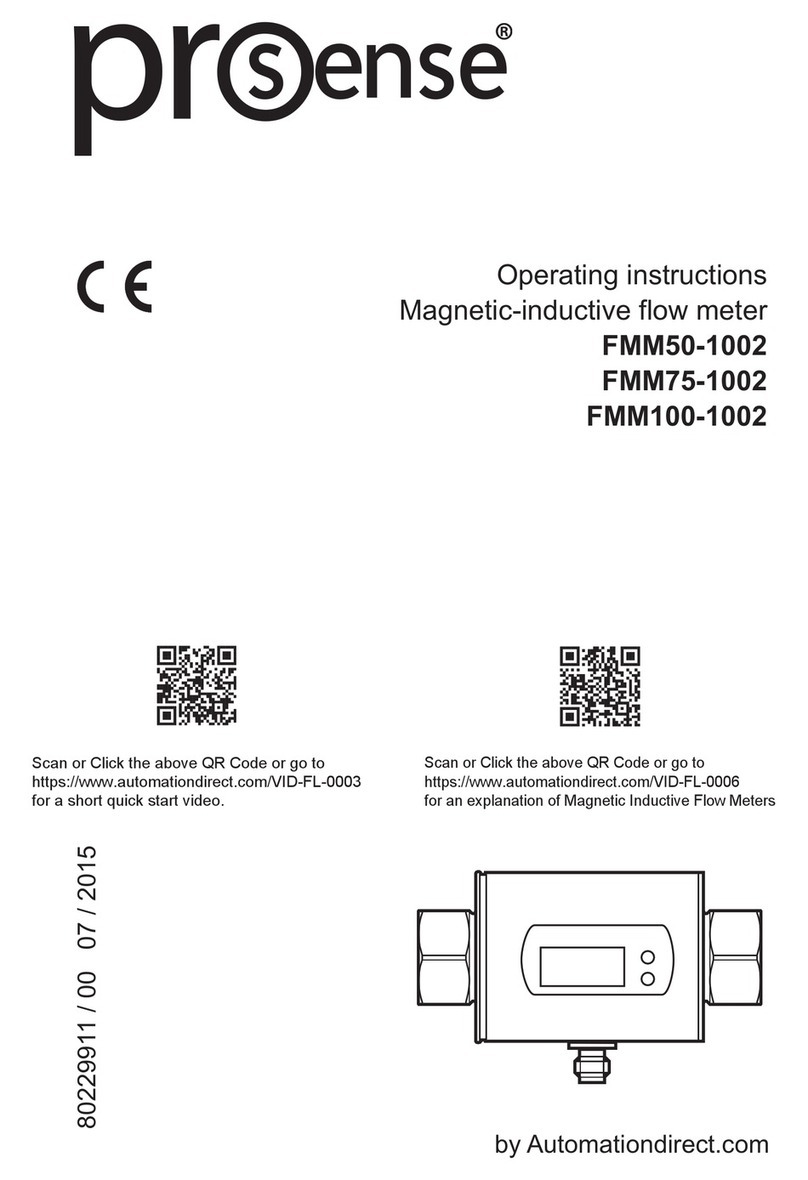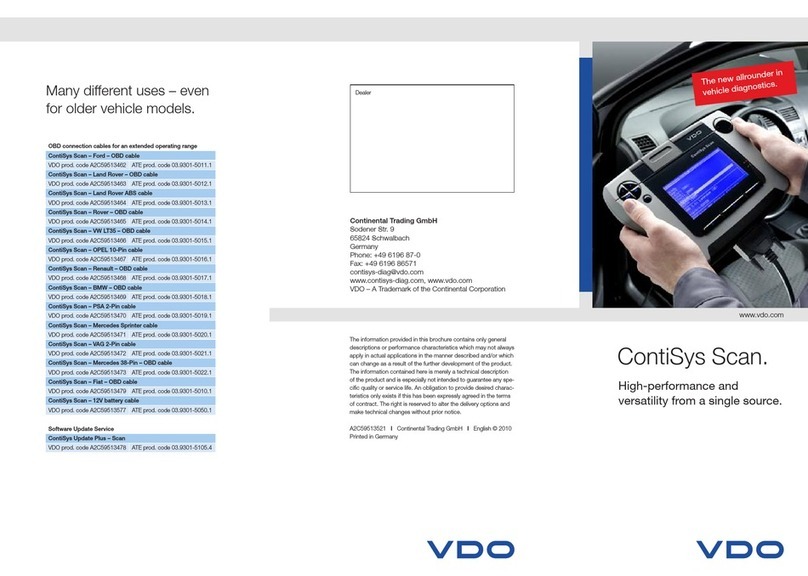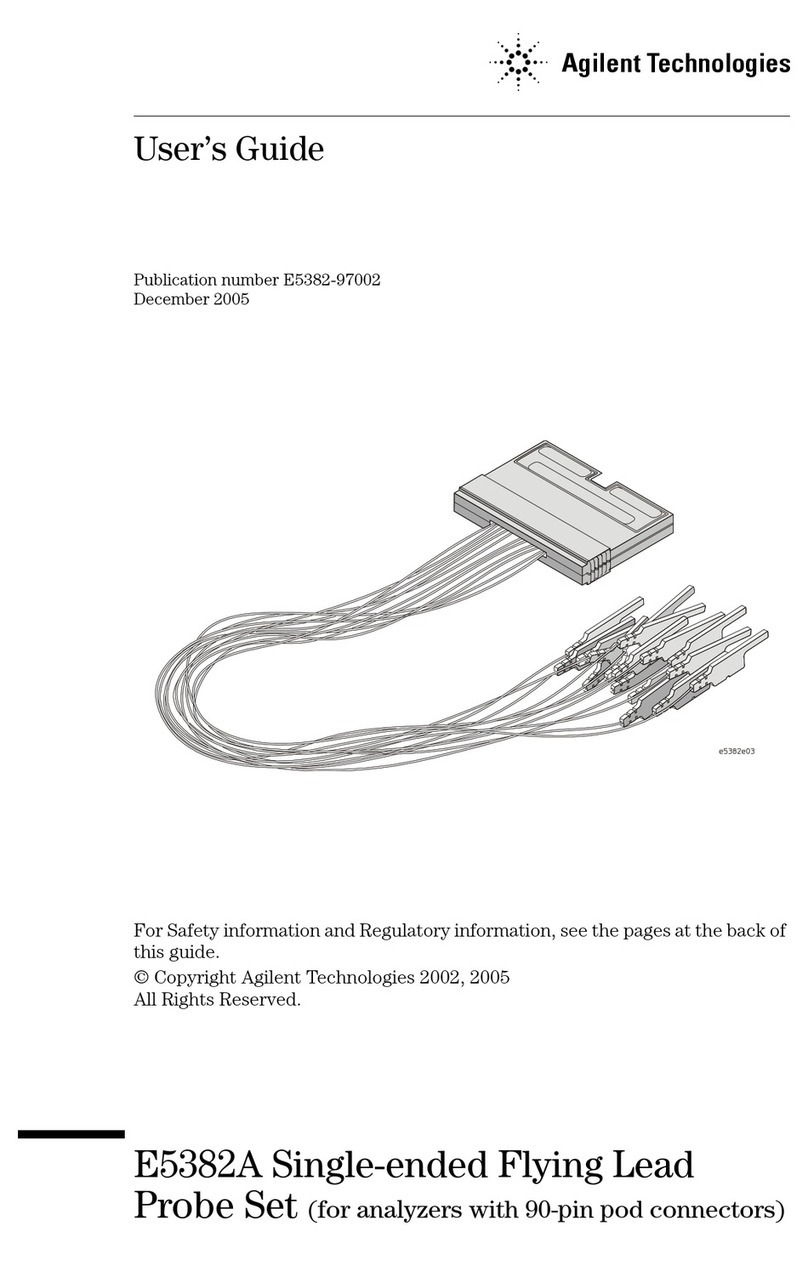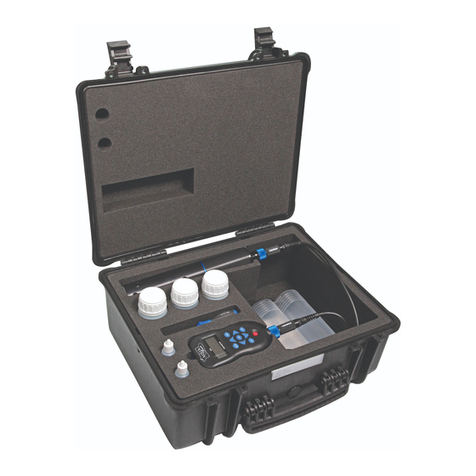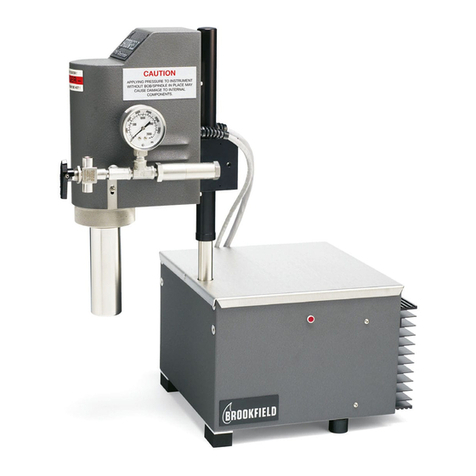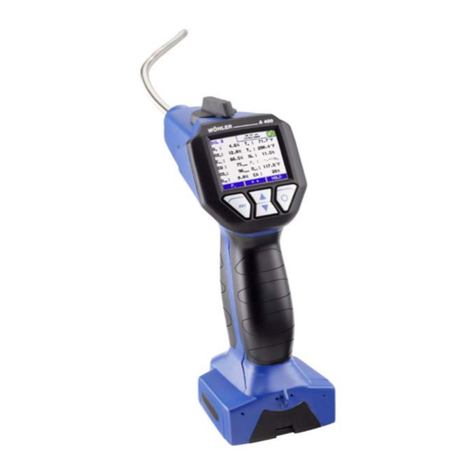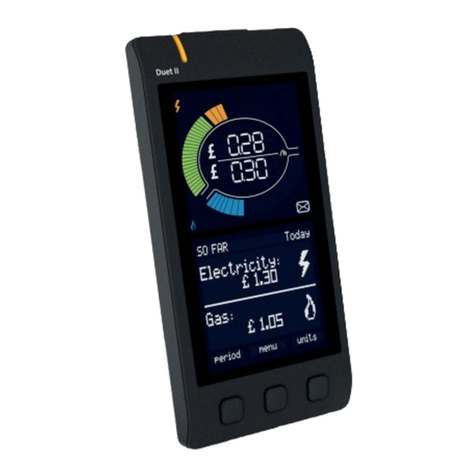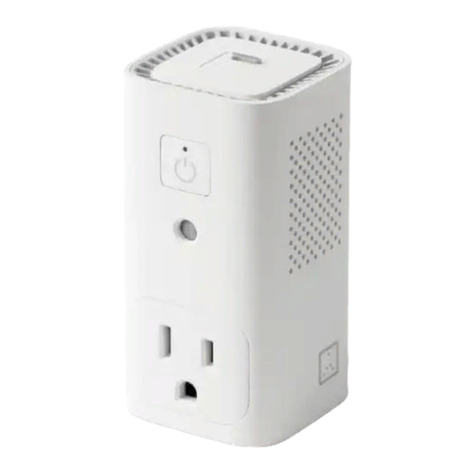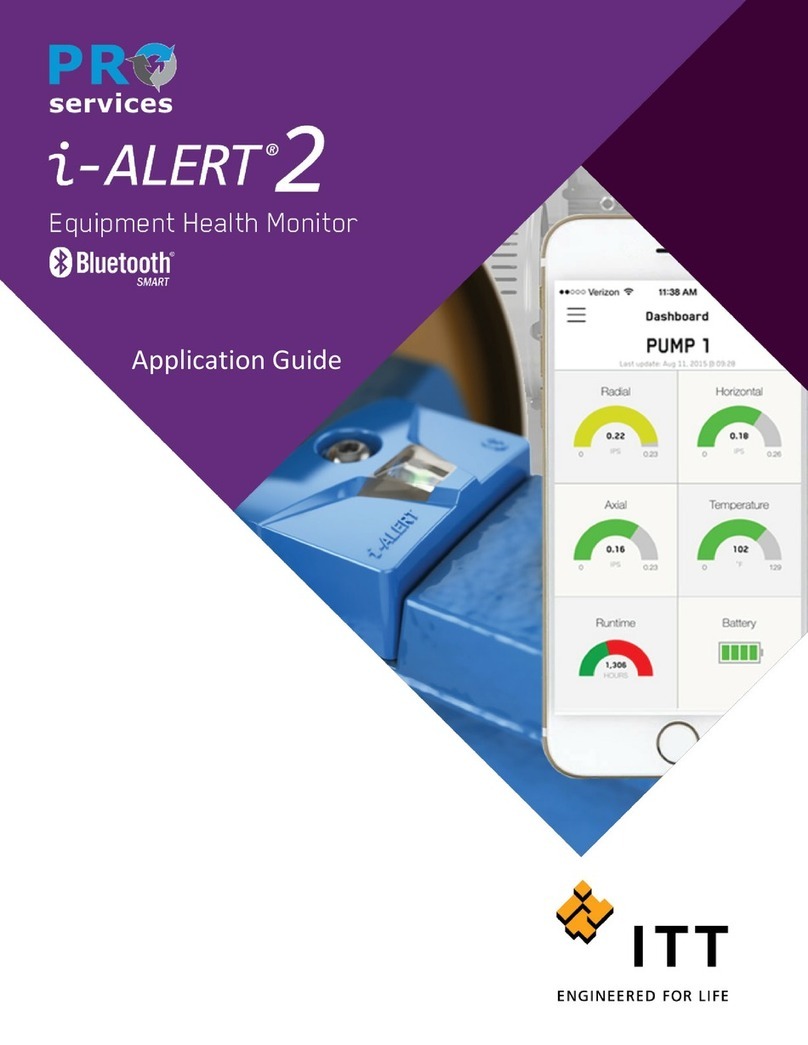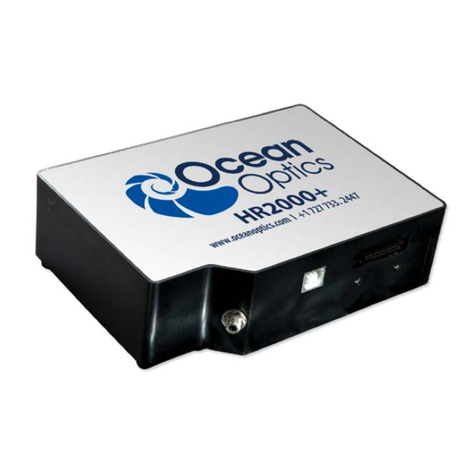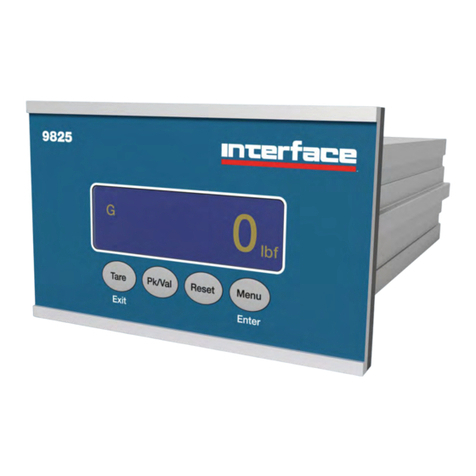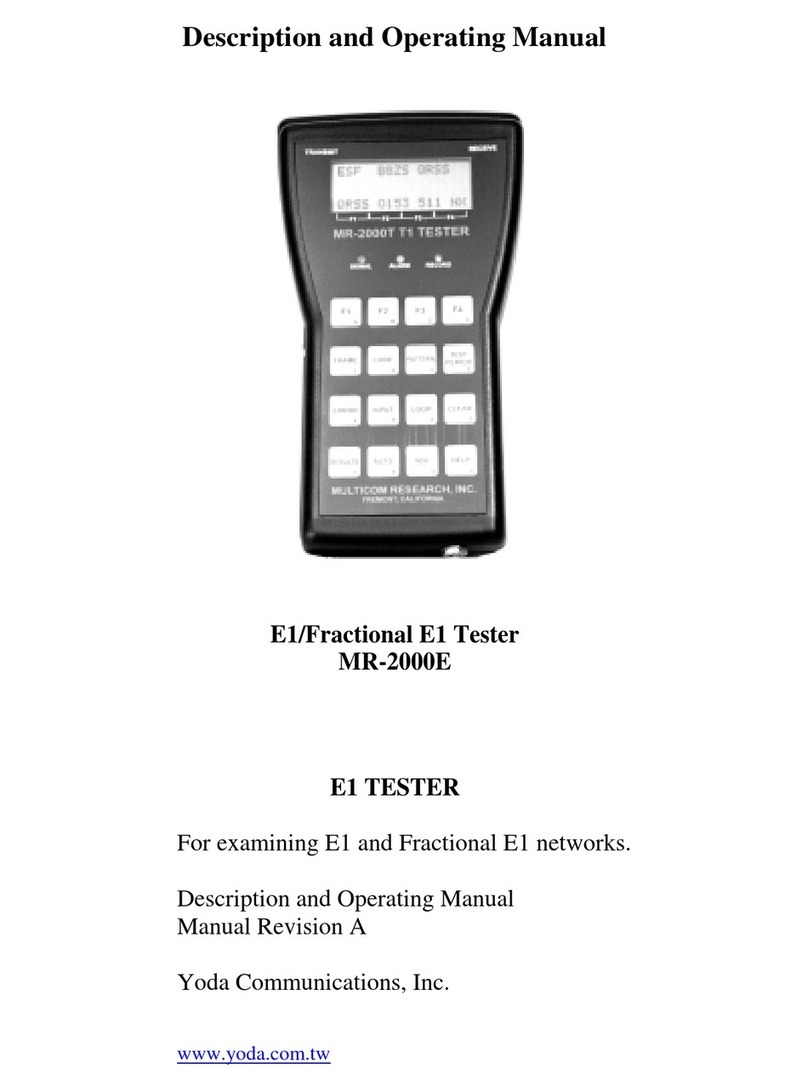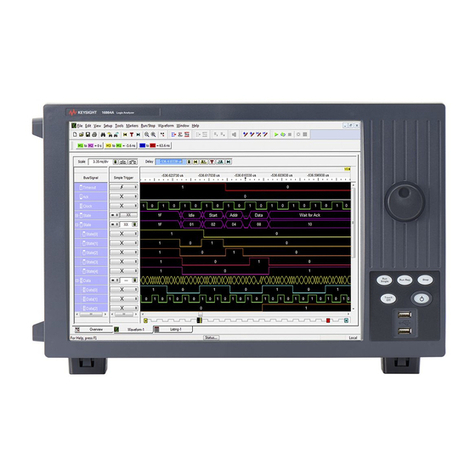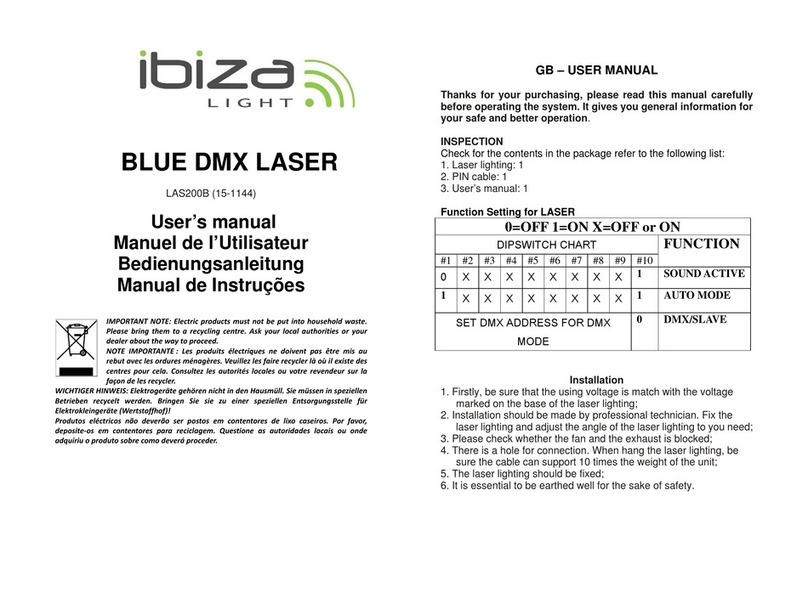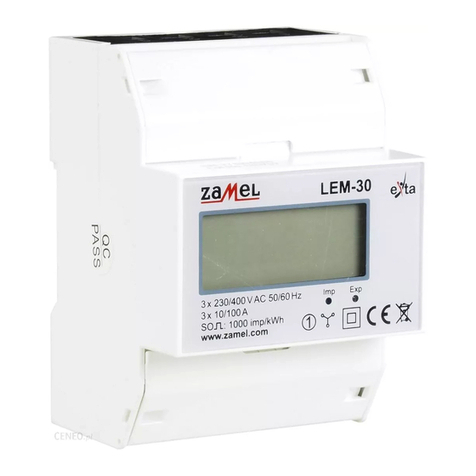Prosense SCU-1400 User manual

~ WARNING ~
This device is designed for connection to hazardous electric voltages. Ignoring this warning can result
in severe personal injury or mechanical damage. To avoid the risk of electric shock and fire, the safety
instructions of this guide must be observed and the guidelines followed. The specifications must not be
exceeded, and the device must only be applied as described in the following. Prior to the commissioning
of the device, this installation guide must be examined carefully. Only qualified personnel (technicians)
should install this device. If the equipment is used in a manner not specified by the manufacturer, the
protection provided by the equipment may be impaired.
Until the device is mounted, do not connect hazardous voltages to the device. The following operations
should only be carried out on a disconnected device and under ESD safe conditions: General mounting,
connection and disconnection of wires.
Do not open the front plate of the device as this will cause damage to the connector for the
display / programming front SCU-PDM1. This device contains no DIP-switches or jumpers. Units must
be mounted on a DIN rail according to DIN 60715
SAFETY INSTRUCTIONS
Receipt and unpacking
Unpack the device without damaging it. The packing should always follow the device until it has been perma-
nently mounted. Check at the receipt of the device to ensure the type corresponds to the one ordered.
Environment
Avoid direct sunlight, dust, high temperatures, mechanical vibrations and shock, as well as rain and heavy
moisture. If necessary, heating in excess of the stated limits for ambient temperatures should be avoided by
way of ventilation. All devices can be used for Measurement / Overvoltage Category II and Pollution Degree
2. The module is designed to operate safely at an altitude of 2000m or less.
Mounting
Mounting and connection of the device should comply with national legislation for mounting of electric
materials, i.e. wire cross section, protective fuse, and location. Descriptions of input / output and supply
connections are shown in this installation guide and on the side label. The following apply to hazardous
voltage-connected devices:
The max. protective fuse is 10A. A power switch shall be easily accessible and close to the device. The power
switch shall be marked as the disconnecting unit for the device.
UL installation requirements
Use 60/75°C copper conductors only.
For use only in pollution degree 2 or better.
Max. ambient temperature ................................................. 60°C (140°F)
Wire size ............................................................................ AWG 26-14
UL file number, SCU-1400, SCU-1600 & SCU-3100....... E191072
The device is an Open Type Listed Process Control Equipment. To prevent injury resulting from accessability
to live parts the equipment must be installed in an enclosure.
FM installation in Division 2 or Zone 2
FM19US0054X ......................... Cl. I, Div. 2, Group A, B, C, D T5 or Cl. I, Div. 2, Zone 2, Group IIC T5
Specific Conditions of Use:
1. The products may be used with the SCU-PDM1 Display/Programming front accessory.
2. The equipment shall be installed in compliance with the enclosure, mounting, spacing and segregation
requirements of the ultimate application, including a tool removable cover.
In Class I, Div. 2 or Zone 2 installations, the subject equipment shall be mounted within a tool secured enclo-
sure which is capable of accepting one or more of Class I, Div. 2 wiring methods specified in the National
Electrical Code (ANSI/NFPA 70). The SCU Series transmitters must be connected to limited output NEC
Class 2 circuits, as outlined in the National Electrical Code® (ANSI / NFPA 70), only. If the devices are
connected to a redundant power supply (two separate power supplies), both must meet this requirement.
Where installed in outdoor or potentially wet locations the enclosure shall at a minimum meet the require-
ments of IP54.
Warning: Substitution of components may impair suitability for Zone 2 / Div. 2.
Warning: To prevent ignition of explosive atmospheres, disconnect power before servicing and do not separate
connectors when energized and an explosive gas mixture is present.
Calibration and adjustment
During calibration and adjustment, the measuring and connection of external voltages must be carried out
according to the specifications of this installation guide. The technician must use tools and instruments that
are safe to use.
Cleaning
When disconnected, the device may be cleaned with a cloth moistened with distilled water.
Technical Specifications
Copyright 2019, Automationdirect.com®
Incorporated All Rights Reserved
3505 HUTCHINSON ROAD
CUMMING, GA 30040-5860
Quick Start Guide
Quick Start Guid
e
Quick Start Guid
e
Universal Signal Conditioners
ProSense Universal Transmitter Signal Conditioner models
SCU-1400, SCU-1600 and SCU-3100 are single input devices
that accept milliampere, voltage, RTD, thermocouple or poten-
tiometer inputs. The SCU-1400 and SCU-1600 models support
a selectable single analog output. The SCU-1600 and SCU-3100
provide two programmable relay outputs. They feature a plastic
slim-line housing, integral 35mm DIN rail mounting adapter,
and removable screw terminals. The detachable SCU-PDM1
programming / display module (purchased separately) is required
for unit configuration. The programming / display module may
remain affixed for operational display of input and output values.
Models:
SCU-1400 - Universal Transmitter with Analog Output
SCU-1600 - Universal Transmitter with Analog and
(2) Relay Outputs
SCU-3100 - Universal Transmitter with (2) Relay Outputs
SCU-PDM1 - Display / Programming Module
Operating temperature .............................. -20°C to +60°C (-4°F to 140°F)
Storage temperature .................................. -20°C to +85°C (-4°F to 185°F)
Supply voltage............................................ 21.6...253 VAC or 19.2...300 VDC
Max. required power:
SCU-1400, SCU-3100............................... ≤2.0 W
SCU-1600.................................................. ≤2.5 W
Max. power dissipation:
SCU-1400, SCU-3100............................... ≤2.0 W
SCU-1600.................................................. ≤2.5 W
Fuse ........................................................... 400mA SB / 250VAC
Isolation voltage, test / operation................ 2.3 kVAC / 250VAC
(reinforced isolation)
EMC immunity influence........................... < ±0.5% of span
Extended EMC immunity:
NAMUR NE 21, A criterion, burst.......... < ±1% of span
Relative humidity........................................ < 95% RH (non-cond.)
Dimensions (HxWxD) ............................... 109 x 23.5 x 104 mm
Dimensions (HxWxD) w/ SCU-PDM1...... 109 x 23.5 x 116 mm
Protection degree ........................................ IP20
Approvals
UL, Standard for Safety .............................. UL 508/C22.2 No. 14
FM ............................................................. 3600, 3611, 3810, ISA 61010-1
Class I, Div. 2, Group A-D, T5
Class I, Div. 2, Group IIC, T5
Zone 2
Observed authority requirements:
EMC ........................................................... 2014/30/EU
LVD ............................................................ 2014/35/EU
RoHS 2........................................................ 2011/65/EU
Model SCU-1400 SCU-1600 SCU-3100
Input
Input for RTD types
Pt10, Pt20, Pt50, Pt100, Pt200,
PT250, Pt300, Pt400, Pt500,
Pt1000, Ni50, Ni100, Ni120,
Ni1000, Cu10, Cu20, Cu50,
Cu100
Pt10, Pt20, Pt50, Pt100, Pt200,
PT250, Pt300, Pt400, Pt500,
Pt1000, Ni50, Ni100, Ni120,
Ni1000, Cu10, Cu20, Cu50,
Cu100
Pt10, Pt20, Pt50, Pt100, Pt200,
PT250, Pt300, Pt400, Pt500,
Pt1000, Ni50, Ni100, Ni120,
Ni1000, Cu10, Cu20, Cu50,
Cu100
Input for TC types B, E, J, K, L, N, R, S, T, U, W3,
W5, LR
B, E, J, K, L, N, R, S, T, U, W3,
W5, LR
B, E, J, K, L, N, R, S, T, U, W3,
W5, LR
Current input ranges 0...20, 4...20 mA 0...20, 4...20 mA 0...20, 4...20 mA
Current input resistance Nom. 20 Ω+ PTC 50 ΩNom. 20 Ω+ PTC 50 ΩNom. 20 Ω+ PTC 50 Ω
Input voltage drop, nom. 1.4 V @ 20 mA 1.4 V @ 20 mA 1.4 V @ 20 mA
Voltage input ranges 0/0.2...1, 0/0.5...2.5, 0/1...5,
0/2...10 VDC
0/0.2...1, 0/0.5...2.5, 0/1...5,
0/2...10 VDC
0/0.2...1, 0/0.5...2.5, 0/1...5,
0/2...10 VDC
Voltage input resistance Nom. 10 MΩNom. 10 MΩNom. 10 MΩ
Output
Current output 0/4...20 mA, 20...0/4 mA 0/4...20 mA, 20...0/4 mA ----------
Load (max.), current output ≤800 Ω ≤ 800 Ω----------
Current limit ≤28 mA ≤28 mA ----------
Voltage output
0...1 / 0.2...1 / 0...10 / 0...5 /
1...5 / 2...10 / 1...0 / 1...0.2 /
5...0 / 5...1 / 10...0 / 10...2 V
0...1 / 0.2...1 / 0...10 / 0...5 /
1...5 / 2...10 / 1...0 / 1...0.2 /
5...0 / 5...1 / 10...0 / 10...2 V
----------
Load (min.), voltage output ≥500 kΩ ≥ 500 kΩ----------
Relay output ---------- 2 x SPST, AC: 500 VA 2 x SPST, AC: 500 VA
Installation:
This installation guide for technical personnel covers the following products:
SCU-1400 SCU-1600 SCU-3100
SCU-PDM1 SCU-CJC1
Mounting SCU-PDM1:
1. Insert the tabs of the SCU-PDM1 into the holes at the top of the device.
2. Swing the SCU-PDM1 down until it snaps into place.
Removing the SCU-PDM1:
3. Push the release button on the bottom of the SCU-PDM1 and swing out and up.
4. With the SCU-PDM1 hinged up, remove it from the holes at the top of the device.
1.
2.
3.
4.
Mounting on DIN rail:
Place top notch of module onto DIN rail and then press lower portion onto DIN rail
until it snaps in place.
Removing from DIN rail:
Remember to remove the connectors with hazardous voltages. Detach the device from
DIN rail by lifting the bottom lock.
Wiring:
Max. wire size 1 x 2.5 mm2 stranded wire. Screw terminal torque 0.5 Nm.
Side Label
Note: Additional specifications available at www.AutomationDirect.com

Configuring a new unit
• Mount the unit on a 35mm DIN rail and connect supply, input
and output wires to the appropriate terminals based on the connec-
tion diagrams in this Quick Start Guide.
• Snap the SCU-PDM1 Programming Module on the front of the
unit.
• Power up the unit.
• The unit should display the configuration menu similar to the
figure below. If not, press ;once.
• Press ;to begin configuration. Press .or ,to scroll
through options on each step. Press ;to confirm an option and
move to the next step.
• Press and hold ;to step backwards through the configuration
menu.
Abbreviations used on the SCU-PDM1 display
FL.ER = flash memory error
AO.ER = no load for current output
(S4-20 mA only)
NO.CO = connection error with SCU-PDM1
IN.ER = error levels on input
TY.ER = configuration in SCU-PDM1
doesn’t match this product
ADV.SET = advanced settings
IN TYPE = input type
V.RANGE = voltage range
I.RANGE = current range
CONNEC. = connecting wires
Pt TYPE = Platinum RTD type
Ni TYPE = Nickel RTD type
TC.TYPE = thermocouple type
DEC.P = decimal place location
SE.BR = a sensor wire is not connected
DECR = decreasing
ACT.DIR = action direction
DISP.LO = display range low
DISP.HI = display range high
REL.UN = relays set in units or % range
Rx.FUNC = relay 1 / 2 function
Rx.CONT = relay 1 / 2 contact type
Rx.SETP = relay 1 / 2 setpoint
Rx.HYST = relay 1 / 2 hysteresis
ERR.ACT = relay action on error
ON.DEL = relay on delay
OFF.DEL = relay off delay
ANA.OUT = analog output
O.RANGE = output range
OUT.ERR = output action on error
OUT.LO = temp for low output
OUT.HI = temp for high output
EN.PASS = enable password
NEW.PAS = new password
CAL.LO = calibrate input low to process value?
CAL.HI = calibrate input high to process value?
USE.CAL = Use process calibration value?
Application Example - Voltage Input to
Current and/or Relay Output
A level sensor with 0-5 VDC output needs to be connected to a 4-20
mA and/or digital inputs input on a PLC. The sensor measures
fluid level between 0 and 60” in a tank. When using the SCU-1600
or SCU-3100, low and high alarms will be set at 5” and 55” respec-
tively with a 3” hysteresis and 5 second on delay set for each alarm.
In the event of a sensor error, both relays will hold in their current
state when the error occured. Relay switching will work as follows:
0” 5” 8” 52”55” 60”
Relay 1 ON Relay 2 ON
• In the configuration menu press .or ,until VOLT is
displayed on line 1. Press ;.
• Select input range. Press .or ,until 0-5 is displayed for
V.RANGE. Press ;.
• Select input units. Press .or ,until in is displayed for UNIT.
Press ;.
• Select decimal point location. Press .or ,until 111.1 is
displayed for DEC.P. Press ;.
• Set display value for minimum input. Press .or ,until 0.0 is
displayed for DISP.LO. Press ;.
• Set display value for maximum input. Press .or ,until 60.0 is
displayed for DISP.HI. Press ;.
Relay Configuration (SCU-1600 and SCU-3100 only)
• Select the relay unit type. Press .or ,until DISP is displayed for REL.UNI.
Press ;.
• Select relay 1 function. Press .or ,until SETP is displayed for R1.FUNC.
Press ;.
• Select relay contact type. Press .or ,until N.O. is displayed for R1.CONT.
Press ;.
• Set relay setpoint. Press .or ,until 5.0 is displayed for R1.SETP.
Press ;.
• Select relay activation decreasing mode. Press .or ,until DECR is displayed
for ACT.DIR. Press ;.
• Set relay hysteresis. Press .or ,until 3.0 is displayed for R1.HYST.
Press ;.
• Set relay on delay in seconds. Press .or ,until 5is displayed for ON.DEL.
Press ;.
• Set relay off delay in seconds. Press .or ,until 0is displayed for OFF.DEL.
Press ;.
• Select relay 2 function. Press .or ,until SETP is displayed for R2.FUNC.
Press ;.
• Select contact type. Press .or ,until N.O. is displayed for R2.CONT.
Press ;.
• Set relay setpoint. Press .or ,until 60.0 is displayed for R2.SETP.
Press ;.
• Select relay activation increasing mode. Press .or ,until INCR is displayed
for ACT.DIR. Press ;.
• Set relay hysteresis. Press .or ,until 3.0 is displayed for R2.HYST.
Press ;.
• Set relay on delay in seconds. Press .or ,until 5is displayed for ON.DEL.
Press ;.
• Set relay off delay in seconds. Press .or ,until 0is displayed for OFF.DEL.
Press ;.
• SCU-1400 and SCU-1600 only Select output mode. Press .or
,until CURR is displayed for ANA.OUT. Press ;.
• SCU-1400 and SCU-1600 only Select output range. Press .or
,until 4-20 is displayed for O.RANGE. Press ;.
• Wait while the settings are stored and the unit switches to run mode.
Once the SCU-1600 or SCU-3100 has been configured, the relay
setpoints can be adjusted very quickly. Press .to adjust RELAY1
and ,to adjust RELAY2. Adjust the setpoint up or down and then
press ;to save the setting and exit the menu. Pressing .and
,simultaneously will change the relay’s state.
Copyright 2019, Automationdirect.com Incorporated/All Rights Reserved Worldwide
Note: If no sensor is connected to the input terminals, SE.BR will flash in the
display when the unit is powered up. Press ;once to acknowledge the
error and then press ;again to display the first screen of the menu as
shown above.
An oven’s temperature is to be monitored using a type K thermo-
couple and a SCU-1400 or SCU-1600. The unit will output a 0-10
VDC signal for a temperature range of 100-400 °F
• In the configuration menu press .or ,until TEMP is
displayed on line 1. Press ;.
• Select sensor type. Press .or ,until TC is displayed for
SENSOR. Press ;.
• Select TC type. Press .or ,until TC.K is displayed for
TC.TYPE. Press ;.
• Select CJC type. Press .or ,until INT is displayed for CJC.
Press ;.
• Select temperature units. Press .or ,until °Fis displayed for
UNIT. Press ;.
• SCU-1600 only - select relay 1 function. Press .or ,until OFF is displayed for
R1.FUNC. Press ;.
• SCU-1600 only - select relay 2 function. Press .or ,until OFF is displayed for
R2.FUNC. Press ;.
• Select output mode. Press .or ,until VOLT is displayed for
ANA.OUT. Press ;.
• Select output range. Press .or ,until 0-10 is displayed for
O.RANGE. Press ;.
• Set temperature for analog output low. Press .or ,until 100.0
is displayed for OUT.LO. Press ;.
• Set temperature for analog output high. Press .or ,until 400.0
is displayed for OUT.HI. Press ;.
• Wait while the settings are stored and the unit switches to run mode.
Application Example - Thermocouple Input Application Example - Voltage Input to
Voltage Output with Custom Scaling - Cont’d
• Wait while these settings are stored and the unit switches to run
mode.
• Press ; to return to the configuration menu.
• Enter Advanced Settings Mode. Press .or ,until YES is
displayed for ADV.SET. Press ;.
• Select custom scaling mode. Press .or ,until CAL is displayed
for SETUP. Press ;.
• Drive the input to a low value. The value does not have to be a
minimum. In this example we will use 5.0 VDC (40 gallons per
minute).
• Select lowpoint. Press .or ,until YES is displayed for CAL.LO
Press ;.
• Set low point. Press .or ,until 40.0 is displayed for gal/
min. Press ;.
• Drive the input to a high value. The value does not have to be a
maximum. In this example we will use 6.0 VDC (60 gallons per
minute).
• Select high point. Press .or ,until YES is displayed for
CAL.HI. Press ;.
• Set high point. Press .or ,until 60.0 is displayed for gal/
min. Press ;.
• Confirm to use custom scaling. Press .or ,until YES is
displayed for USE.CAL. Press ;.
• Wait while the settings are stored and the unit switches to run mode.
A flow sensor, connected to a SCU-1400 or SCU-1600, delivers
a 3-7 VDC output over a range of 0-80 gallons per minute. The
signal conditioner will convert the 3-7 VDC input signal to a
0-10 VDC output signal. The unit must first be configured to the
voltage output range. The two-point calibration mode in Advanced
Settings is then used to set the custom input range.
• In the configuration menu press .or ,until VOLT is
displayed on line 1. Press ;.
• Select input range. Press .or ,until 0-10 is displayed for
V-RANGE. Press ;.
• Select input units. Press .or ,until gal/min is displayed for
UNIT. Press ;.
• Select decimal point location. Press .or ,until 111.1 is
displayed for DEC.P. Press ;.
• Set display for minimum input. Press .or ,until 0.0 is
displayed for DISP.LO. Press ;.
• Set display for maximum input. Press .or ,until 80.0 is
displayed for DISP.HI. Press ;.
Select the relay unit type. Press .or ,until DISP is displayed for REL.UNI.
Press ;.
• SCU-1600 only - select relay 1 function. Press .or ,until OFF is displayed for
R1.FUNC. Press ;.
• SCU-1600 only - select relay 2 function. Press .or ,until OFF is displayed for
R2.FUNC. Press ;.
• Select output mode. Press .or ,until VOLT is displayed for
ANA.OUT. Press ;.
• Set output range. Press .or ,until 0-10 is displayed for
O.RANGE. Press ;.
Application Example Continued above.
Application Example - Voltage Input to
Voltage Output with Custom Scaling
Several useful functions are in the Advanced Settings Menu. To get
to the Advanced Settings Menu, Press .or ,until YES is
displayed for the first screen of the configuration menu that looks
like this:
The configuration of the SCU-1400, SCU-1600 or SCU-3100
can be saved into the SCU-PDM1. The SCU-PDM1 can then be
moved to another unit (must be the same part number) and the
configuration loaded into the new unit.
• Enter Advanced Settings menu and then press .or ,until
MEM is displayed for SETUP. Press ;.
• To save the configuration into the SCU-PDM1. Press .or ,
until SAVE is displayed for MEMORY. Press ;.
• To load the configuration from the SCU-PDM1 into the SCU-1400,
SCU-1600 or SCU-3100. Press .or ,until LOAD is displayed
for MEMORY. Press ;.
Password Protection allows the user to create a 4-digit password
(0000-9999) to prevent tampering with configuration settings if the
SCU-PDM1 is left mounted to the front of the signal conditioner.
• Enter Advanced Settings menu and then press .or ,until
PASS is displayed for SETUP. Press ;.
• To enable password protection. Press .or ,until YES is
displayed for EN.PASS. Press ;.
• To set a password. Press .or ,until the desired code is
displayed for NEW.PAS. Press ;.
Note: The default password 2008 allows access to all configuration menus. The
default password cannot be changed.
Advanced Operations
Additional Help and Support
• For product support, specifications, installation and
troubleshooting, a Hardware User Manual can be
downloaded from the On-line Documentation area of the
AutomationDirect web site.
• For additional technical support and questions, call out
Technical Support team @ 1-800-633-0405 or 770-844-4200
21 22 24
23
R1 R2
11 12 14
13
+
-mA
11 12 14
13
+
-V
31 32 33
41 42 44
43
+
-
41 42 44
43
42 44
43
41 41 42 44
43
+
-Tx
41 42 44
43
+
-
41 42 44
43
41 42 44
43
+
-
41 42 44
43
41 42 44
43
11 12 14
13
+
-V
Inputs:
Outputs:
Supply:
Voltage, 1 VVoltage, 10 VCurrent
Relays (only available on
SCU-1600 and SCU-3100)
RTD, 3- / 4-wire
Resistance,
3- / 4-wire
Voltage
Potentiometer Current2-wire transmitter
RTD, 2-wire
Resistance, 2-wire
TC, internal CJC
41 42 44
CJC
+
-
TC, optional external CJC
Accessory (SCU-CJC1 order separately)
Wiring Diagrams
Note: Help text for each abbreviation will scroll across the SCU-PDM1
This manual suits for next models
3
Other Prosense Measuring Instrument manuals
